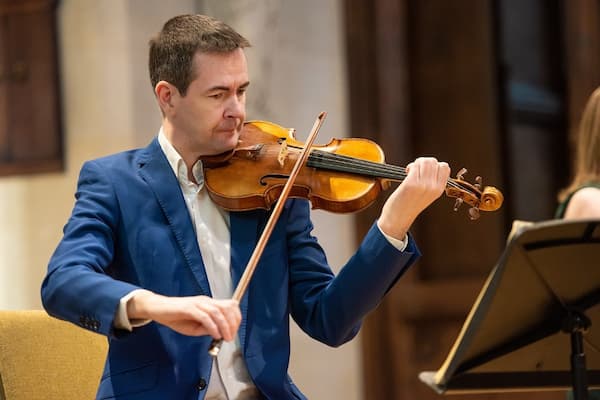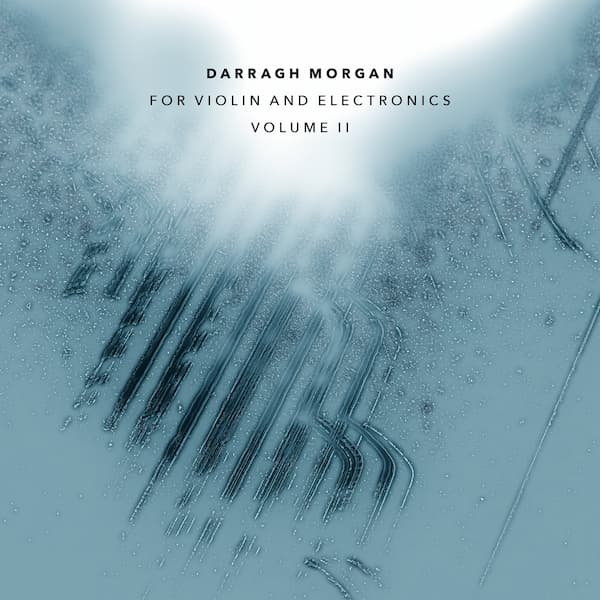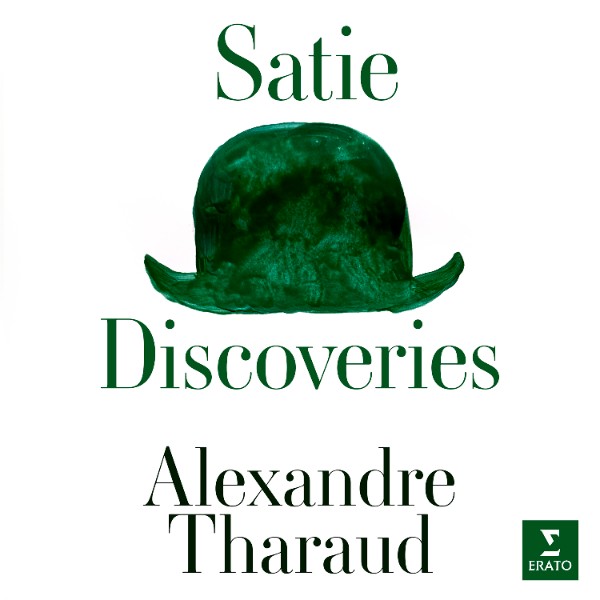It is a rare, stupendous, and overwhelmingly promising feat when the first track of an album brings you to tears. It is nonetheless a feat that Darragh Morgan’s new release For Violin and Electronics II has achieved for me on this swelteringly warm June evening. The opening track, Shiva Feshareki’s Zohra, shimmers with beguiling, miraculously co-existing discord and euphony, a spluttering electronic heartbeat underpinning the fragmented and fractal melodies that careen above. There is a rawness here, in both emotion and pitched material, like touching one’s finger directly to a nerve. With such an opening, an implicit promise is made to the listener: the album will not only showcase entirely new paradigms for treatment of electronics and the violin – it will also make you feel.

Darragh Morgan © darraghmorgan.com
The tracklist continues with Zack Browning’s Sole Injection, a delightfully bifurcated, adrenal, and neurologically stimulating composition. As listeners, we are near-constantly and unpredictably teleported between different planes of musical material, from synths to more organic-sounding violin. The musical ideas and tempi are sufficiently varied to create a kind of rollercoaster stomach-drop effect, while still retaining a certain cohesion. When using headphones or split speakers, this effect is enhanced with thoughtful left-right panning. Gradually, Browning gives us little glimpses of surreal singularities: violin melodies doubled with uncannily low synth, longer uninterrupted stretches of material without panning, brief snatches of more traditional bowing figurations. This is intense, at times challenging, but rewarding listening: a soundworld of lit-up brain scans, of firing on all cylinders, of cerebral play.
From Browning’s aesthetically futuristic auditory landscape, we move into Robin Rimbaud’s A Cantegral Segment, which evokes for me a kind of prehistoric, wordless melancholy. Percussive violin elements drip and echo, creating a cavernous feel, while hypnotic drone-swathes envelop and dissipate. Breath-sounds, carefully pitch-restricted harmonics, and papery circular bowing make up a timbral feast in this remarkably focused sonic meditation.
In and amongst all of this variety, Darragh Morgan’s confident, verve-filled performance is a true bedrock and constant. Equally at home with fragile, glassy techniques as he is with hearty, warm chops and double-stops, Morgan’s musical sensibility is translated in the thoughtful curation and sequencing of the album. As Browning remarks in the liner notes, Morgan’s “instinctive musicality” makes him “the perfect dance partner with the computer” in this, his second album, exploring the possibilities of the intersection between violin and electronics.

Alongside his numerous accolades as a performer and soloist, Morgan is known as a tastemaker and champion of new music and for his track record of working closely with composers. A sense of Morgan’s collaborative approach to music-making is translated in the public interviews available between the violinist and composers such as Christopher Fox, Gerald Barry, and Richard Causton. Between reminiscing about the journey a particular piece has taken (“from Tehran to a cold church in Bethnal Green” on a solo violin work by Fox), and tracing the origins of a particular composition through a long-standing collaborative relationship, Morgan always asks insightful questions about compositional process and inspiration, betraying a profound curiosity, care, and attention to detail.
The album continues with Donnacha Dennehy’s kaleidoscopic and gentle Overstrung. The piece is playfully named, as the work’s harmonic language grew out of the pitches that are produced in the overtone series. This is done in a way that is only possible with electronics, as the strings and some of the samples themselves are retuned to give a much greater variety of harmonic overtones than is typically feasible. The result is beautiful and has the lilting, dazzling quality of sunlight dancing on water.
Ibukun Sunday’s approach to the liner notes of the fifth track fixation is enigmatic. He tells us that the piece deals with “obsession or strong emotional attachment for a listener or performer,” leaving us to decide for ourselves what this might mean as we experience the work. Structurally, the music seems to “unfurl:” a long, fluid melody builds and then ceases, and in its wake, we are left with drone, shimmering transients, and cantabile melodic fragments. We spend two-thirds of the music luxuriating in the atmospheric wake of that first gorgeous opening bloom. As such, we almost miss the piece before it is even over, and it is perhaps here that we find our “fixation.”
In direct contrast, Andrew Poppy’s Poems and Toccatas No. 3 and No. 9 is always “now,” always moving. Uniting gurgles of bass, drum-hits, insistent violin, and frenetic piano, the complete forty-minute suite has been performed at myriad venues, sometimes with prerecorded synth mixed with violin live by the composer.
The album as a whole is dedicated to Mira Calix, South African producer, multidisciplinary artist, and the composer of track seven, just one more thing: “a piece about love,” in her own words. In just one more thing, a mournful, throaty melody guides us through an amorphous forest of sound. A vocal chorale of sorts sits at the back of the mix, emerging and disappearing. Fluttering, flickering textural electronic effects tickle the ears, pre-dating fixtures of glitch and hyperpop, which were yet to emerge at the time of the piece’s composition in 2012. Little moments of tremolo and machinal glissandi-whirs in the electronics provide decoration as the piece winds to a close.
Penultimate track liminalis by Irene Buckley is inspired by liminality, a concept she describes as “the threshold between two realities.” The electronic swells are lushly realised, spacious depths in the bass as well as carefully balanced higher frequencies, granting a living, organic quality. Here, Morgan showcases his most glassy, otherworldly timbral capabilities. The unveiling of the second, lower violin voice – intertwined in a mesmerising dance with the upper – is a truly goosebump-giving moment. This is music of wonder; of star-gazing, or uncannily close encounters with whales at sea.
Frank Lyon’s Dazed by the Haze draws the album to a close with a tribute to Morgan and Lyon’s mutual love of Jimi Hendrix, the result dense and frenetic, with moments of truly virtuosic cadenza from Morgan.
Darragh Morgan’s For Violin and Electronics Volume II is a profound accomplishment for all involved. The range of musical moods gives this album broad and visceral appeal within classical music and beyond, without sacrificing any of the experimental and curious spirit central to new music. The album’s entries feel storied and diverse, the result of longstanding international friendship and collaboration. The implicit promise made with Feshareki’s Zohra at the opening of the album is fulfilled upon listening: this is cutting-edge and emotional music, which we need now more than ever.
For more of the best in classical music, sign up for our E-Newsletter
Rakhi Singh: Sabkha (Rakhi Singh, vocals/violin/electronics)

